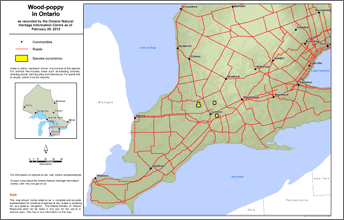Wood-poppy
Scientific name: Stylophorum diphyllum

Cover photo credit: Allen Woodliffe
Status
Endangered
“Endangered” means the species lives in the wild in Ontario but is facing imminent extinction or extirpation.
Date added to the Species at Risk in Ontario List
The Wood-poppy was already assessed as endangered when the Endangered Species Act took effect in 2008.
What it looks like
Wood-poppy is a perennial herb that reaches up to 40 centimetres in height. The long-stalked leaves are mostly found near the base of the plant and are deeply divided into five to seven main lobes, which are themselves irregularly lobed.
The flowers of the Wood-poppy are four-petaled, occurring in few-flowered clusters. Petals are an intense yellow and flowers bloom in May to early June. The fruit is a nodding, greyish-green, soft-bristly capsule, The seeds are dispersed in late June to July when the fruit splits open.
Where it lives
In Ontario, Wood-poppy is found in rich mixed deciduous woodlands, forested ravines and slopes, and along wooded streams.
It is possible that Wood-poppy is still found in these areas because they were unsuitable for agriculture, rather than being reflective of its true habitat requirements.
Wood-poppy grows in full shade, although the cultivated variety does well in partial sun. Associated dominant trees include: Sugar Maple, White Ash, American Beech, Black Cherry, and Hackberry.
Where it’s been found in Ontario
In Canada, there are only three known populations of Wood-poppy found in southwestern Ontario, all in the county of Middlesex.
View a larger version of this map (PDF)
What threatens it
The primary threat to Wood-poppy is habitat loss and degradation due to residential development and road-building, agricultural expansion, logging, recreational activities and the impact of invasive species such as Garlic Mustard and Japanese Knotweed.
Action we are taking
Endangered Species and their general habitat are automatically protected
Recovery strategy
A recovery strategy advises the ministry on ways to ensure healthy numbers of the species return to Ontario.
Read the executive summary (February 18, 2011)
Read the recovery strategy (February 18, 2011)
Government response statement
A government response statement outlines the actions the government intends to take or support to help recover the species.
Read the government response statement (November 18, 2011)
Five-Year Review of Progress
A five-year review reports on progress made toward protecting and recovering a species, within five years of publishing a species’ government response statement.
Read the report on progress towards the protection and recovery of 27 species at risk, including Wood-poppy (2016).
Habitat protection
General Habitat Protection - June 30, 2008
What you can do
Report a sighting
- Report a sighting of an endangered animal or plant to the Natural Heritage Information Centre. Photographs with specific locations or mapping coordinates are always helpful.
Volunteer
- Volunteer with your local nature club or provincial park to participate in surveys or stewardship work focused on species at risk.
Be a good steward
- Private land owners have a very important role to play in species recovery. If you find Wood-poppy on your land, you may be eligible for stewardship programs that support the protection and recovery of species at risk and their habitats.
- Invasive species seriously threaten many of Ontario’s species at risk. To learn what you can do to help reduce the threat of invasive species, visit:
www.ontario.ca/invasivespecies
www.invadingspecies.com
www.ontarioinvasiveplants.ca
Report illegal activity
- Report any illegal activity related to plants and wildlife to
1-877-TIP-SMNR (847-7667) .
Quick facts
- An individual Wood-poppy can produce over 1000 seeds in one year!
- Wood-poppy seeds have an "elaiosome", which is a fleshy structure that is rich in lipids and proteins. Ants, which are attracted to these elaiosomes, carry them back to their nests, feed them to their larvae, and then discard the intact seed. In doing this, the ants serve as dispersers of the Wood-poppy seeds.
- Wood-poppy seeds require a period of cold and moist conditions (i.e. winter) in order to successfully germinate. This process is known as "stratification".
